|
|
 |
Peter von Cornelius
|
|
German Realist Painter, 1783-1867
German painter, draughtsman and teacher. He was a leading figure in the 19th-century revival of fresco painting for the decoration of public buildings. In both his own work and his teaching he was more concerned with conception and design than with the execution of the finished work. |
|
 |
Peter von Hess
|
|
(29 July 1792, Dseldorf - 4 April 1871, Menchen) was a German painter, known for historic paintings, especially of the Napoleonic Wars and the Greek War of Independence.
Peter von Hess initially received training from his father Carl Ernst Christopher Hess. He accompanied his younger brother Heinrich Maria to Munich in 1806, and enrolled at the Munich Academy at the age of sixteenth. He also trained under Wilhelm von Kobell.
During the Napoleonic Wars, he was allowed to join the staff of General Wrede, who commanded the Bavarians in the military operations which led to the abdication of Napoleon. There he gained novel experiences of war and a taste for extensive travel. During this time, von Hess painted his first battle pieces. In 1818 he spent some time in Italy where he painted landscapes and various Italian scenes.
In 1833, at Ludwig's request, he accompanied Otto of Greece to the newly formed Kingdom of Greece, where at Athens he gathered materials for pictures of the war of liberation. The sketches which he then made were placed, forty in number, in the Pinakothek, after being copied in wax on a large scale by Nilsen, in the northern arcades of the Hofgarten at Munich. King Otho's entrance into Nauplia was the subject of a large and crowded canvas now in the Pinakothek, which Hess executed in person.
|
|
 |
Petere Lely
|
|
painted Julia Fasey, Lady Crewe in 17th century
|
|
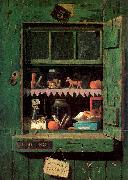 |
Peto, John Frederick
|
|
American, 1854-1907
American painter. He trained at the Pennsylvania Academy of Fine Arts (1877-8), Philadelphia, where he became a friend of William Michael Harnett whose work was a dominant influence on his oeuvre. Peto maintained a studio in Philadelphia, exhibiting at the Academy from 1879 to 1887; he earned a living through occasional work as a photographer, sculptor and painter. After moving to Island Heights, NJ, in 1889, |
|
|
|
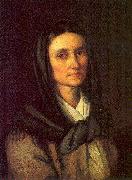 |
Petrich, Soma Orlai
|
|
Hungarian, 1822-1880
was a Hungarian painter. Petrich was born to a Serbian father and Hungarian mother. He originally wanted to become a writer. He was a pupil of Jakab Marastoni in 1846 and attended F. Waldmuller's school in Vienna from 1847. He often painted historical themese and in his lithographs he portrayed experiences during the war of independence. He studied at Kaulbach in Munich from 1850. He painted "The Corpse of Louis II" in 1851, |
|
|
|
|
|
 |
Petrus Christus
|
|
Flemish 1415-1473
Petrus Christus Locations
South Netherlandish painter.
His known artistic career began in Bruges on 6 July 1444 when, as the Poorterboek (citizens register) for that day reveals, he purchased his citizenship ... in order to be a painter. Town records show that he and his wife became members of the Confraternity of the Dry Tree c. 1462; that in 1463 he and another painter, Pieter Nachtegale, were paid for the construction of a Tree of Jesse (destr.) and for the cost of assistants employed on the day of the religious procession in which it was used; and that on 19 March 1472 he served as a representative of the painters guild in a dispute with another painter, Jehan de Hervy the elder ( fl 1472-1507). These and a few other scattered references comprise the existing documentation for Christusa life and work. |
|
 |
Philip Alexius de Laszlo
|
|
Philip Alexius de Laszlo, MVO (30 April 1869 Budapest - 22 November 1937 London) was a Hungarian painter known particularly for his portraits of royal and aristocratic personages.
Laszlo was born in Budapest as Laub Fulop Elek (Hungarian style with the surname first), the eldest son of a Jewish tailor. The family changed its name to Laszlo in 1891.
As a young man, Laszlo apprenticed to a photographer while studying art, eventually earning a place at the National Academy of Art, where he studied under Bertalan Szekely and Karoly Lotz. He followed this with studies in Munich and Paris. Laszlo's portrait of Pope Leo XIII earned him a Grand Gold Medal at the Paris International Exhibition in 1900.
In 1903 Laszlo moved from Budapest to Vienna. In 1907 he moved to England. He remained based in London for the rest of his life while traveling the world to fulfill commissions.
Laszlo's patrons awarded him numerous honors and medals. In 1909 he was named an honorary Member of the Royal Victorian Order by King Edward VII of the United Kingdom. In 1912 he was ennobled by King Franz Joseph of Hungary; his surname became "Laszlo de Lombos". The family later shortened the name to "de Laszlo".
Laszlo became a British citizen in 1914 but was interned for over twelve months in 1917 and 1918 during the First World War.
|
|
 |
Philip Charles Hardwick
|
|
English architect , (1822-1892),
was a notable English architect of the 19th century who was once described as "a careful and industrious student of mediaeval art". He was born in Westminster and was the son of the architect Philip Hardwick (1792-1870), grandson of Thomas Hardwick (junior) (1752-1825) and great grandson of Thomas Hardwick Senior (1725-1825); the Hardwicks' architectural work spanned over 100 years, making them one of the most successful architectural families in British history. Hardwick's mother was also from an eminent architectural family: the Shaws. His maternal grandfather was John Shaw Senior (1776-1832) and his uncle was John Shaw Jr (1803-1870) - both architects known for their work at Christ's Hospital and at Ramsgate harbour. Philip Charles trained under his father and also in Edward Blore's office during which time he visited Belgium and Germany. Hardwick exhibited regularly at the Royal Academy between 1848 and 1854. Like his father, Philip Charles was employed in the 'Square Mile' of the City of London, where he became the leading architect of grandiose banking offices, mainly in an Italianate manner, setting the pattern for suburban and provincial designs for almost three decades. He designed five City banks, including Drummond's in Trafalgar Square (1879-81), and was architect to the Bank of England from 1855 to 1883. However, he was more employed outside London, designing branch offices at Hull (1856) and Leeds (1862-65). His best known work was the Great Hall of London's Euston railway station (opened on 27 May 1849). The Great Hall was demolished in 1962 to make way for construction of the current Euston Station building. Philip Charles was the last Hardwick Surveyor to St Bartholomew's Hospital in London and was a major benefactor of the hospital. |
|
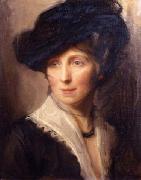 |
Philip de Laszlo
|
|
MVO (born 30 April 1869, Budapest - died 22 November 1937, London) was a Hungarian painter known particularly for his portraits of royal and aristocratic personages.
Leszle was born in Budapest as Laub Felöp Elek (Hungarian style with the surname first), the eldest son of a Jewish tailor. The family changed its name to Leszle in 1891. He apprenticed at an early age to a photographer while studying art, eventually earning a place at the National Academy of Art, where he studied under Bertalan Szekely and Keroly Lotz. He followed this with studies in Munich and Paris. Leszle's portrait of Pope Leo XIII earned him a Grand Gold Medal at the Paris International Exhibition in 1900. In 1903 Leszle moved from Budapest to Vienna. In 1907 he moved to England and remained based in London for the remainder of his life, although traveling the world to fulfill commissions. |
|
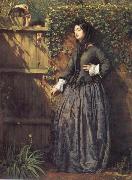 |
Philip Hermogenes Calderon
|
|
English genre, portraits, domestic and historical scenes Painter, 1833-1898
English painter of Spanish and French descent. His father, at one time a Roman Catholic priest, was Professor of Spanish Literature at King's College, London. Calderon studied at James M. Leigh's school in London in 1850, then in Paris at the studio of Fran?ois-Edouard Picot. He lived near by in Montmartre, sharing a room with fellow art student Henry Stacy Marks. He exhibited his first Royal Academy painting, By the Waters of Babylon (London, Tate), in 1853 and thereafter became a regular exhibitor until 1897. He first made his name with Broken Vows (London, Tate), exhibited in 1857. The painting shows a woman overhearing through a garden fence her lover betraying her and was painted in the detailed, clean-cut style associated with the Pre-Raphaelites. |
|
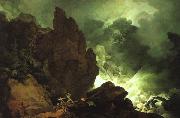 |
Philip James de Loutherbourg
|
|
1740-1812
French (Resident in UK)
Philip James de Loutherbourg Gallery
Philip James de Loutherbourg, also seen as Philippe-Jacques and Philipp Jakob and with the appellation the Younger (31 October 1740 ?C 11 March 1812) was an English artist of French origin.
He was born in Strasbourg, where his father, the representative of a Polish family, practised miniature painting; but he spent the greater part of his life in London, where he was naturalized, and exerted a considerable influence on the scenery of the English stage, as well as on the artists of the following generation. De Loutherbourg was intended for the Lutheran ministry, and was educated at the University of Strasbourg.
As the calling, however, was foreign to his nature, he insisted on being a painter, and placed himself under Charles-Andr?? van Loo in Paris. The result was an immediate and precocious development of his powers, and he became a figure in the fashionable society of that day. In 1767 he was elected into the French Academy below the age required by the law of the institution, and painted landscapes, sea storms, battles, all of which had a celebrity above those of the specialists then working in Paris. His debut was made by the exhibition of twelve pictures, including Storm at Sunset, Night, Morning after Rain.
He is next found travelling in Switzerland, Germany and Italy, distinguishing himself as much by mechanical inventions as by painting. One of these, showing quite new effects produced in a model theatre, was the wonder of the day. The exhibition of lights behind canvas representing the moon and stars, the illusory appearance of running water produced by clear blue sheets of metal and gauze, with loose threads of silver, and so on, were his devices. In 1771 he came to London, and was employed by David Garrick, who offered him £500 a year to apply his inventions to Drury Lane, and to superintend the scene-painting, which he did with complete success, making a new era in the adjuncts of the stage. Garrick's own piece, the Christmas Tale, and the pantomime, 1781-1782, introduced the novelties to the public, and the delight not only of the masses, but of Reynolds and the artists, was unbounded. The green trees gradually became russet, the moon rose and lit the edges of passing clouds, and all the world was captivated by effects we now take little notice of. A still greater triumph awaited him on his opening an entertainment called the Eidophusikon, which showed the rise, progress and result of a storm at sea that which destroyed the great Indiaman, the Halsewell,and the Fallen Angels raising the Palace of Pandemonium. De Loutherbourg has been called the inventor of the panorama, but this honor does not belong to him, although it first appeared about the same time as the eidophusicon. The first panorama was painted and exhibited by Scottish painter Robert Barker. |
|
|
|
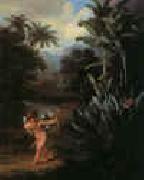 |
Philip Reinagle
|
|
1802-1835
British
Philip Reinagle Gallery
Philip Reinagle entered the schools of the Royal Academy in 1769, and afterwards became a pupil of Allan Ramsay (1713-1784), whom he assisted in the numerous portraits of George III and Queen Charlotte. He exhibited first at the Royal Academy in 1773, sending portraits almost exclusively until 1785, when the monotonous work of producing replicas of royal portraits appears to have given him a distaste for portraiture, and to have led him to abandon it for animal painting. He became very successful in his treatment of sporting dogs, especially spaniels, of birds, and of dead game. In 1787, however, he sent to the academy a 'View taken from Brackendale Hill, Norfolk,' and from that time his exhibited works were chiefly landscapes. He was elected an associate of the Royal Academy in 1787, but did not become an academician until 1812, when he presented as his diploma picture 'An Eagle and a Vulture disputing with a Hyaena'. He likewise exhibited frequently at the British Institution.
Reinagle was also an accomplished copyist of the Dutch masters, and his reproductions of the cattle-pieces and landscapes of Paul Potter, Ruysdael, Hobbema, Berchem, Wouwerman, Adnaan van de Velde, Karel Dujardin, and others have often been passed off as originals. He also made some of the drawings for Robert John Thornton's New Illustration of the Sexual System of Linnaeus, 1799-1807, and for his Philosophy of Botany, 1809-10 ; but his best drawings for book illustration were those of dogs for William Taplin's Sportsman's Cabinet, 1803, which were admirably engraved by John Scott.[1]
Reinagle died at 5 York Place, Chelsea, London, on 27 Nov. 1833, aged 84. A drawing by him, 'Fox-hunting the Death', is in the collection of the Victoria and Albert Museum. Reinagle's daughter Frances Arabella was married to John Levett-Yeats, grandson of the English merchant and planter Francis Levett. His son, Ramsey Richard Reingate, was also an artist, and followed his father's style. |
|
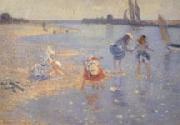 |
Philip Wilson Steer
|
|
English Painter, 1860-1942
was an English artist. Philip Wilson Steer was born in Birkenhead, the son of the portrait painter Philip Steer (1810-1871). After finding the examinations of the Civil Service too demanding, he became an artist in 1878. He studied at the Gloucester School of Art and then from 1880 to 1881 at the South Kensington Drawing Schools. He was rejected by the Royal Academy of Art and so studied in Paris between 1882 and 1884. He studied at the Acad??mie Julian, and then in the École des Beaux Arts under Cabanel. There he became one of the few English Impressionists. He is known for his landscapes, such as 'The Beach at Walberswick' (1890; Tate Gallery, London). He became a leader (with Walter Sickert) of the English Impressionist movement and was one of the founders of the New English Art Club in 1886. During the First World War, he was recruited by Lord Beaverbrook, the Minister of Information, to paint pictures of the Royal Navy. |
|
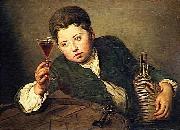 |
Philipe Mercier
|
|
Philippe Mercier (also known as Philip Mercier) (Berlin, 1689 - London, 18 July 1760) was a French painter and etcher, who lived principally and was active in England. He was born in Berlin of French extraction, the son of a Huguenot tapestry-worker. He studied painting at the Akademie der Wissenschaften of Berlin[1] and later under Antoine Pesne, who had arrived in Berlin in 1710. Later, he traveled in Italy and France before arriving in Londone"recommended by the Court at Hannover"eprobably in 1716. He married in London in 1719 and lived in Leicester Fields.
He was appointed principal painter and librarian to the Prince and Princess of Wales at their independent establishment in Leicester Fields, and while he was in favor he painted various portraits of the Royalties, and no doubt many of the nobility and gentry. Of the Royal portraits, those of the Prince of Wales and of his three sisters, painted in 1728, were all engraved in mezzotint by Jean Pierre Simon, and that of the three elder children of the Prince of Wales by the John Faber Junior in 1744. This last was a typical piece of Mercier's composition, the children being made the subject of a spirited, if somewhat childish, allegory in their game of play. Prince George is represented with a firelock on his shoulder, teaching a dog his drill, while his little brother and sister are equally occupied in a scene that is aptly used to point a patriotic moral embodied in some verses subjoined to the plate
|
|
 |
Philipp Hieronymus Brinckmann
|
|
(or Brinkman,) a German painter and engraver, was born at Spires in 1709. He was a pupil of J. G. Dathan. His favourite subjects were landscapes, but he also painted historical subjects and portraits; in some of the latter he imitated the force and colouring of Rembrandt. He was painter to the Court, and keeper of the Gallery at Mannheim, where he died in 1761. In the Städel at Frankfort is a 'Swiss Landscape' signed P. H. Brinckmann fecit, 1745. He etched some plates in a picturesque and spirited style. |
|
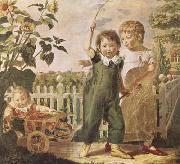 |
Philipp Otto Runge
|
|
German Romantic Painter, 1777-1810
..German painter, draughtsman and theorist. He stands alongside Caspar David Friedrich as a leading figure in German Romantic painting even though his early death restricted his oeuvre to relatively few stages of development. The enduring prominence of philosophical and theoretical concerns suggests that further work would have contributed to the history of ideas as well as to that of art. Runge's greatest influence was on later, largely 20th-century artists and thinkers rather than on his immediate contemporaries. While 19th-century developments certainly bore out Runge's claim for a new, symbolic role for landscape, |
|
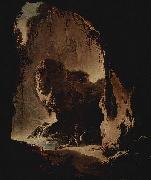 |
Philipp Peter Roos
|
|
(later surnamed Rosa di Tivoli; 1651-1706), was a German Baroque painter.
He was born in Frankfurt am Main and learned to paint from his father, the landscape painter Johann Heinrich Roos.He was the brother of the painter Johann Melchior Roos, who briefly worked with him in Italy. As a young man, he painted in the style of his father. He was called to paint for Charles I, Landgrave of Hesse-Kassel, who liked him so much, he gave him a sum of money to travel to Rome with,which he did in 1677. He became a member of the Bentvueghels with the nickname "Mercury" and earned money making small paintings and sketches for tourists.
He fell in love with the daughter of Giacinto Brandi, whom he later married. They lived in a large house in Tivoli, near Rome, whence his surname. In Tivoli, they kept a menagerie of various animals so Roos could draw from live poses. This house was called the "Noah's Ark" by their friends. In his Italian style, he painted life-size figures and animals in a broad manner and a heavy brown tone. |
|
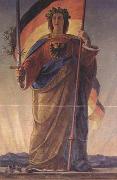 |
Philipp veit
|
|
1793 - 1877) was a German Romantic painter.German painter. The stepson, from 1804, of Friedrich von Schlegel, he studied (1808-11) at the Akademie in Dresden under Friedrich Matth?i (1777-1845) and Caspar David Friedrich. He showed talent in drawing but, on moving to Vienna in 1811, had difficulties with painting in oil, and turned to watercolour. Through Schlegel, Veit came to know many of the leading Romantics in Vienna, such as the poet and novelist Joseph von Eichendorff. In 1813-14 Veit took part in the campaign against Napoleon and returned briefly to Berlin. In 1815 he completed a votive picture, the Virgin with Christ and St John, for the church of St James in Heiligenstadt, Vienna (in situ), inspired by the work of Pietro Perugino and Raphael. In 1815 Veit left for Italy where he stayed until 1830. In Rome he joined the circle around Friedrich Overbeck and Peter Cornelius, becoming a leading Nazarene (see NAZARENES). With these artists he took part in providing fresco decorations (1816-17) for the Casa Bartholdy (now the Bibliotheca Hertziana): Veit painted the scene of Joseph and Potiphar's Wife and a decorative lunette allegory, the Seven Years of Plenty (both now Berlin, Staatl. Mussen, N.G.). In 1818 Veit was commissioned to paint the fresco of the Triumph of Religion in the Museo Chiaramonti in the Vatican, one of a series of murals recording the services of Pope Pius VII to science and art. |
|
|
|
|
|
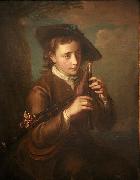 |
Philippe Mercier
|
|
(also known as Philip Mercier) (Berlin, 1689 - London, 18 July 1760) was a French painter and etcher, who lived principally and was active in England. He was born in Berlin of French extraction, the son of a Huguenot tapestry-worker. He studied painting at the Akademie der Wissenschaften of Berlin[1] and later under Antoine Pesne, who had arrived in Berlin in 1710. Later, he traveled in Italy and France before arriving in Londone"recommended by the Court at Hannover"eprobably in 1716. He married in London in 1719 and lived in Leicester Fields.
He was appointed principal painter and librarian to the Prince and Princess of Wales at their independent establishment in Leicester Fields, and while he was in favor he painted various portraits of the Royalties, and no doubt many of the nobility and gentry. Of the Royal portraits, those of the Prince of Wales and of his three sisters, painted in 1728, were all engraved in mezzotint by Jean Pierre Simon, and that of the three elder children of the Prince of Wales by the John Faber Junior in 1744. This last was a typical piece of Mercier's composition, the children being made the subject of a spirited, if somewhat childish, allegory in their game of play. Prince George is represented with a firelock on his shoulder, teaching a dog his drill, while his little brother and sister are equally occupied in a scene that is aptly used to point a patriotic
|
|
 |
Philippe Rousseau
|
|
Paris 1816 - Acquigny 1887.
French Painter.
French Painter. French painter. He may have received his artistic training in the studios of Gros and Jean-Victor Bertin, since he credited them as his masters when he exhibited at the Salon. He began exhibiting in 1834 with a View of Normandy (untraced) and for the next six Salons he exhibited landscapes. In 1844 he began to show still-lifes. In 1845 he was awarded a third-class medal, and in 1847 his still-lifes were admired by Th?ophile Thor?, who was one of the earliest critics to recognize Rousseau's debt to Chardin. This influence became the subject for his 1867 Salon entry, Chardin and his Models (untraced, see McCoubrey, no. 15). The work is far grander and more cluttered in its conception than most still-lifes by Chardin and alludes to the master by faithfully reproducing some of his favourite objects within a traditional table-top format rather than by an analysis of his compositional devices. |
|
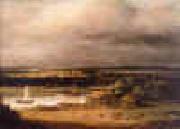 |
Philips Koninck
|
|
1619-1688
Dutch
Philips Koninck Gallery
Little is known of his history except that he was said to be a pupil of Rembrandt, whose influence is to be seen in much of his work. He painted chiefly broad, sunny landscapes, full of space, light and atmosphere; they are seen from a high perspective, allowing a prominent view of the sky. Portraits by him, somewhat in the manner of Rembrandt, also exist (e.g. see Joost van den Vondel); there are examples of these in the galleries at Copenhagen and Oslo. Of his landscapes, the principal are View at the mouth of a river at the Hague, with a slightly larger replica in the National Gallery, London; Woodland border and countryside (with figures by Adriaen van de Velde) at Amsterdam; and landscapes in Brussels, Florence (the Uffizi), Berlin and Cologne. Koninck, a prosperous businessman, appears to have painted few pictures during the last decade of his life.
Several of his works have been falsely attributed to Rembrandt and many more to his namesake and fellow townsman Salomon de Koninck (1609-1656), also a disciple of Rembrandt, whose paintings and etchings consist mainly of portraits and biblical scenes.
Both of these painters are to be distinguished from David Koninck (1636?-1687), also known as Rammelaar. David Koninck was born in Antwerp and studied there under Jan Fyt. He later settled in Rome, where he is stated to have died in 1687; this, however, is doubtful. His pictures are chiefly landscapes with animals and still life.
|
|
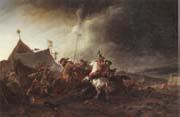 |
Philips Wouwerman
|
|
Dutch Baroque Era Painter, 1619-1668
Dutch painter and draughtsman. He was the eldest son of the painter Paulus [Pauwels] Joostens Wouwerman of Alkmaar (d 28 Sept 1642), whose two other sons, Pieter Wouwerman (1623-82) and Johannes Wouwerman (1629-66), also became painters. Philips probably received his first painting lessons from his father, none of whose work has been identified. According to Cornelis de Bie, Wouwerman was next apprenticed to Frans Hals, although no trace of Hals's influence is discernible in Wouwerman's work. Wouwerman is also reputed to have spent several weeks in 1638 or 1639 working in Hamburg in the studio of the German history painter Evert Decker (d 1647). While in Hamburg, he married Annetje Pietersz. van Broeckhof. On 4 September 1640 Wouwerman joined the Guild of St Luke in Haarlem, in which in 1646 he held the office of vinder (agent or 'finder'). Given the many southern elements in his landscapes, it has repeatedly been suggested that Wouwerman must have travelled to France or Italy, but there is no documentary evidence that he left his native Haarlem for more than short periods. |
|
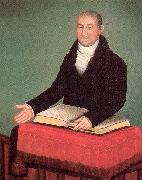 |
Phillips, Ammi
|
|
American Folk Artist, 1788-1865
American painter. Apparently self-taught, he began his prolific and successful career as a portrait painter c. 1811. During his lifetime, he moved several times across the borders of New York, western Connecticut and Massachusetts in search of commissions. Like many of the itinerant artists of the 19th century, he struggled to achieve pictorial solutions and a distinctive style, yet he developed so dramatically that historians originally classified his paintings as the work of two different artists: 'The Border Limner' and 'The Kent Limner'. The earliest works, from his 'Border' period (c. 1812-19), are marked by simple forms, shaded outlines and soft, pastel colours. They include ambitious full-length portraits as well as three-quarter and bust-length examples (Dr Russell Dorr, c. 1814-15; Williamsburg, VA, Rockefeller Flk A. Col.). In the 1820s he experimented with techniques and formats, developing an attention to detail and naturalism that suggests the influence of Albany portrait painter Ezra Ames. By the 1830s, the decade of his 'Kent' portraits, his compositions present his sitters as large, stylized shapes that nearly fill the canvas, while his use of rich, saturated colours creates striking contrasts of light and dark. Typically in this decade, his female sitters are shown leaning forward while male sitters sit upright with one hand draped over a chairback. Among his most appealing and successful works are portraits of children from this period. Blond Boy with Primer, |
|
 |
Phillips, Thomas
|
|
English, 1770-1845
From a respectable but impoverished family, he left school aged 13 to be apprenticed to Francis Eginton of Birmingham, a glass painter and early pioneer in reproduction by a 'photographic method'. The chiaroscuro effects of this process were a lasting influence on Phillips's style. In 1790 he moved to London to study at the Royal Academy and simultaneously assisted in Benjamin West's studio. He exhibited at the Royal Academy from 1794 to 1844 and was elected ARA in 1804, RA in 1808 and Professor of Painting in succession to Henry Fuseli from 1825 to 1832. |
|
 |
Phoebe Traquair
|
|
The leading artist the Arts and Crafts movement in Edinburgh at the turn of the century ,
(1852-1936) |
|
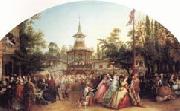 |
Phoebus Levin
|
|
fl. 1836-1878 was born in Berlin but exhibited in London from 1855-1878 |
|
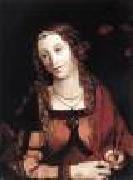 |
PIAZZA, Callisto
|
|
Italian painter, Lombard school (b. ca. 1500, Lodi, d. ca. 1561, Lodi)
Early collaborative projects with Martino and Albertino remain problematic. He probably moved to Brescia in 1523; the first major extant dated work is a Nativity (1524; Brescia, Pin. Civ. Tosio-Martinengo), painted for S Clemente, Brescia. In Brescia he studied the work of Moretto da Brescia and of Gerolamo Romanino, with whom he may have collaborated. Their influence is seen in the Visitation (1525; Brescia, S Maria Calchera) and especially in the group of works painted for churches in the Valcamonica. These include a Deposition (1527; Esine parish church); a Virgin Enthroned with Saints (Breno, S Antonio); a frescoed lunette of the Virgin Enthroned with Saints |
|
|
|
 |
Picknell, William Lamb
|
|
American, 1853-1897
was a United States painter of landscapes, coastal views, and figure genres, known for his rapid painting style. He was born in Hinesburg, Vermont and died in Marblehead, |
|
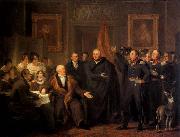 |
PIENEMAN, Jan Willem.
|
|
b. 1779, Abcoude, d. 1853, Amsterdam,Painter, teacher, engraver and museum director. He trained with a wallpaper painter in Amsterdam, and at the same time he followed courses at the Amsterdam Stadstekenacademie, where he soon distinguished himself. His artistic and didactic gifts were recognized by the Napoleonic government, which in 1805 appointed him professor of drawing at the artillery and engineering school in Amersfoort. In 1816 he was appointed assistant director of the Mauritshuis at The Hague by William I. He frequently spent time at the Dutch court, where he gave painting lessons to Queen Wilhelmina and painted many portraits of members of the royal family. He also produced a few engravings. |
|
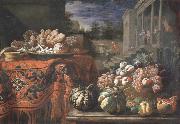 |
Pier Francesco Cittadini
|
|
Italian, 1616-1681,was an Italian painter of the Baroque period, active mainly in Bologna and painting lush and rich still lifes. Also known as Pier Francesco Cittadini. Originally trained in Rome then studied with Guido Reni. Also called il Milanese. He painted still life pictures. His two sons Giovanni Battista Cittadini and Carlo Cittadini were also still life painters. |
|
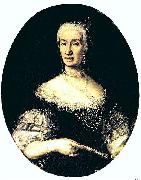 |
Pier Francesco Guala
|
|
(15 September 1698 - 27 February 1757), also known as Pierfrancesco and Pietro Francesco, was an eighteenth-century Italian painter active for the most part in the region of his place of birth, Casale Monferrato.
Guala was the seventh of eight siblings of whom only he and a sister survived infancy. His mother died when he was five and he was brought up by his father, Lorenzo, who himself was a painter and perhaps related to the architect Sebastiano Guala.
Pier Francesco Guala died in Milan on 27 February 1757.
|
|
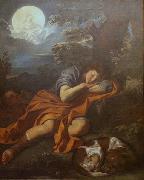 |
Pier Francesco Mola
|
|
(9 February 1612 - 13 May 1666) was an Italian painter of the High Baroque, mainly active around Rome.
Mola was born at Coldrerio (now in Ticino, Switzerland). At the age of four, he moved to Rome with his father Giovanni Battista, a painter. With the exception of the years 1633 - 40 and 1641 - 47, during which he resided in Venice and Bologna, respectively, he lived for the rest of his life in Rome.
His early training was with the late mannerist painter Cavalier D'Arpino, and he worked under the classicizing Francesco Albani.
His masterpiece is the fresco in the gallery of Alexander VII in the Quirinal Palace Gallery, entitled Joseph making himself known to his Brethren (1657). He made six versions of The Flight into Egypt, the earileist and best of which is the first one, The Rest on the Flight into Egypt.
He was elected Principe of the Accademia di San Luca, the Roman artists' professional association, in 1662, but his last years were neither profitable nor prolific. One of his pupils was Antonio Gherardi.
With his looser style and handling, more naturalistic palette, and interest in exploring landscape elements, Mola rebelled against the prevailing, highly-theoretical classicism of such leading 17th-century Roman painters as Andrea Sacchi.
|
|
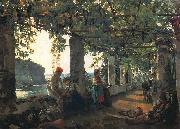 |
Pier Leone Ghezzi
|
|
(Rome, 28 June 1674 - Rome, 6 March 1755) was an Italian Rococo painter and caricaturist active in Rome.
Caricature of composer Antonio Vivaldi by Pier Leone GhezziGhezzi was born in Rome. His father, Giuseppe Ghezzi, (1634-1721), also trained Antonio Amorosi, and was a secretary to the Roman Accademia di San Luca. Pier Leone himself joined the Academy in 1705 and he executed a painting, the Allegory of Gratitude, to be donated to the institution, as was customary.
He was the godson of Carlo Maratta. Pier Leone is known for his frescoes in the Villa Falconieri of Frascati.
His pen and gouache caricatures are much freer in emotion than his state portraiture, and often depict named individuals or professions in satirical fashion.
|
|
 |
Piero della Francesca
|
|
Italian Early Renaissance Painter, ca.1422-1492 Italian painter and theorist. His work is the embodiment of rational, calm, monumental painting in the Italian Early Renaissance, an age in which art and science were indissolubly linked through the writings of Leon Battista Alberti. Born two generations before Leonardo da Vinci, Piero was similarly interested in the scientific application of the recently discovered rules of perspective to narrative or devotional painting, especially in fresco, of which he was an imaginative master; and although he was less universally creative than Leonardo and worked in an earlier idiom, he was equally keen to experiment with painting technique. Piero was as adept at resolving problems in Euclid, whose modern rediscovery is largely due to him, as he was at creating serene, memorable figures, whose gestures are as telling and spare as those in the frescoes of Giotto or Masaccio. His tactile, gravely convincing figures are also indebted to the sculpture of Donatello, an equally attentive observer of Classical antiquity. In his best works, such as the frescoes in the Bacci Chapel in S Francesco, Arezzo, there is an ideal balance between his serene, classical compositions and the figures that inhabit them, the whole depicted in a distinctive and economical language. In his autograph works Piero was a perfectionist, creating precise, logical and light-filled images (although analysis of their perspective schemes shows that these were always subordinated to narrative effect). However, he often delegated important passages of works (e.g. the Arezzo frescoes) to an ordinary, even incompetent, assistant. |
|
 |
Piero di Cosimo
|
|
1462-1521
Italian Piero di Cosimo Galleries
Italian painter and draughtsman.
Tax declarations made by Piero di Cosimo's father suggest that the artist was born in either 1461 or 1462. According to the first, he was eight years old in 1469, while a catasto (land registry declaration) of 1480 gives his age as 18. A document of 1457 establishes that his father, Lorenzo di Piero d'Antonio, was a maker of small tools (succhiellinaio) rather than a goldsmith, as Vasari claimed. By 1480 Piero appears no longer to have been living at the family house in the Via della Scala, Florence, but was an unsalaried apprentice or workshop assistant to Cosimo Rosselli, from whom he received room and board and eventually took the name of Piero di Cosimo. |
|
 |
piero ligorio
|
|
Ligorio was born in Naples. In 1534 he moved to Rome, where he developed his interest in antiquities, and was named superintendent to the ancient monuments by the Popes Pius IV and Paul IV. In 1549 he began excavations in the Hadrian's Villa at Tivoli and designed his masterwork, the water works at Villa d'Este, for Cardinal Ippolito II d'Este. He also played a role in designing the fountains at Villa Lante in Bagnaio, working alongside Vignola. His Mannerist taste is present also in the Casina Pio IV (also known as Villa Pia) at the Vatican (1559?C1562).
In 1568 he was fired by Paul V for having criticized Michelangelo's work in St. Peter's Basilica, and moved to Ferrara, where he was guest of Duke Alfonso II d'Este.
As a scholar of antiquities, one of his most famous published works is a map of ancient Rome (Antiquae Urbis Imago) from 1561.
He died in Ferrara in 1583. |
|
|
|
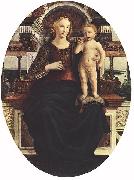 |
Piero Pollaiuolo
|
|
(c. 1443 - 1496), also known as Piero Benci, was an Italian Renaissance painter from Florence. His brother was the artist Antonio del Pollaiolo and the two frequently worked together. Their work shows both classical influences and an interest in human anatomy; reportedly, the brothers carried out dissections to improve their knowledge of the subject.
He died in Rome in 1496.
|
|
 |
Pierre Albert Marquet Prints
|
|
French 1875- 1947
Marquet was born in Bordeaux. In 1890 he moved to Paris to attend the Decorative Arts School, where he met Henri Matisse. They were roommates for a time, and they influenced each other's work. Marquet began studies in 1892 at the École des Beaux-Arts under Gustave Moreau, a symbolist artist who was a follower of the Romantic tradition of Eug??ne Delacroix.
In these years, Marquet exhibited paintings at the Salon des Ind??pendants. Although he did not sell many paintings, the artistic community of Paris became aware of his work. His early compositions were characterised by a clear and painterly Fauvist approach, in which he had a fine control of the drawing and responded to light, not only by intensifying the strongest tones, but also by seeing the weaker ones in coloristic terms.
In 1905 he exhibited at the Salon d'Automne where his paintings were put together with those of Henri Matisse, Maurice de Vlaminck, Andr?? Derain, Othon Friesz, Georges Rouault, Raoul Dufy, Henri Manguin, Georges Braque, Louis Valtat and Jean Puy.
Dismayed by the intense coloration in these paintings, critics reacted by naming the artists the "Fauves", i.e. savage beasts. Although Marquet painted with the fauves for years, he used less bright and violent colours than the others, and emphasized less intense tones made by mixing complementaries, thus always as colors and never as grays.
At the end of 1907 he stayed in Paris and dedicated himself, together with Henri Matisse, to a series of city views. The fundamental difference between the two is that while Matisse used strong colours, Marquet favored grayed yellows, greyed violets or blues. Black was usually used as a violent contrast to light colors for such forms as bare tree trunks or calligraphically drawn people contrasted with very light, often yellow or orange streets and sidewalks. Another difference is that Marquet used an approximation of traditional perspective, although his colors and compositions constantly referred to the rectangle and cut its plane with their calligraphy.
From 1907 to his death, Marquet alternated between working in his studio in Paris and many parts of the European coast and in North Africa. He was most involved with Algeria and Algiers and with Tunisia. In his voyages he painted the sea and ships, but also the lights and animated life of the city, especially cities on the waterfront, like Algiers.
Among European cities Marquet remained impressed particularly with Naples and Venice where he painted the sea and boats, accenting the light over water. He adopted a technique nothing like the Impressionists', painting water as a large area of simple tone which held the plane of the water surface without illusionistic perspective, from which the ships arise into a different plane. His views of the lagoon in Venice do this very economically. The water stays at a right angle to the picture plane and the large ships float with ease, with their reflections exactly the correct tone to project the required space. His color is much like Matisse of the 1920s, here. His contrasts of vivid colors describe the waves of the sea with simple drawing which accompany the exactly observed color tones, giving a scene of placid movement. The human figures are much simplified, calligraphically drawn in a way related to Japanese Shijo style work. Matisse is said to have called him "our Hokusai".
During his voyages to Germany and Sweden he painted the subjects he usually preferred: river and sea views, ports and ships, but also cityscapes. Over the course of his career he often returned to the same subjects, even years later, recording subtle differences in the light. He painted a few portraits, and between 1910 and 1914 he painted a series of nudes in whorehouses, and prepared the illustration of a work on lesbian lovers. But he is best known for his many landscapes.
Unlike Matisse, there are no obvious periods of change in his work. To the end he was one of Matisse's closest friends, and they discussed each other's work with the greatest openness. His death was unexpected and sudden, from a gall bladder attack and subsequently discovered cancer, for which at that time there was no therapy. Marquet died in Paris, on 14 June 1947. |
|
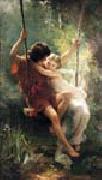 |
Pierre Auguste Cot
|
|
(February 17, 1837 ?C 1883) was a French painter of the Academic Classicism school.
He was born in B??darieux, and initially studied at l'Ecole des Beaux-Arts in Toulouse before going to Paris. He studied under Leon Cogniet, Alexandre Cabanel and William-Adolphe Bouguereau. From the 1870s, his popularity grew quickly. In 1874 he was made Chevalier of the Legion of Honour. He created several works of lasting popularity, including Le Printemps, featuring two young lovers sitting upon a swing, and The Storm. Both these paintings are on display at the Metropolitan Museum of Art in New York City; |
|
|
|
|
|
|
|
|

